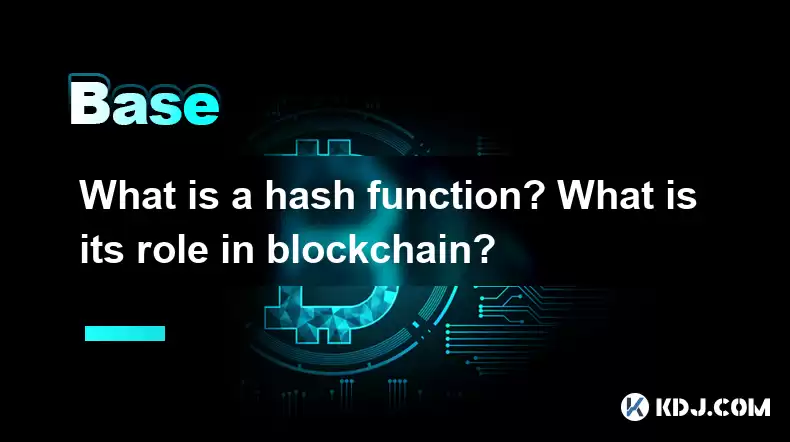-
 bitcoin
bitcoin $102877.190955 USD
1.88% -
 ethereum
ethereum $3430.435064 USD
4.52% -
 tether
tether $0.999264 USD
-0.05% -
 xrp
xrp $2.307310 USD
4.49% -
 bnb
bnb $987.740692 USD
3.82% -
 solana
solana $161.947760 USD
3.97% -
 usd-coin
usd-coin $0.999712 USD
-0.05% -
 tron
tron $0.292810 USD
2.93% -
 dogecoin
dogecoin $0.179738 USD
10.70% -
 cardano
cardano $0.580716 USD
8.75% -
 hyperliquid
hyperliquid $42.463448 USD
8.40% -
 chainlink
chainlink $15.763437 USD
7.05% -
 zcash
zcash $649.595636 USD
17.21% -
 bitcoin-cash
bitcoin-cash $511.610261 USD
7.19% -
 stellar
stellar $0.292537 USD
7.91%
What is a hash function? What is its role in blockchain?
Hash functions, crucial to blockchain security, create fixed-size outputs from any input data, ensuring data integrity and immutability by detecting even minor changes. Different types exist, each offering varying security levels.
Mar 05, 2025 at 02:30 pm

- A hash function is a cryptographic algorithm that transforms any input data into a fixed-size string of characters, called a hash.
- This process is deterministic, meaning the same input will always produce the same output.
- Hash functions are crucial for blockchain technology, providing data integrity and security.
- They ensure the immutability of the blockchain by detecting any changes to the data.
- Different types of hash functions exist, each with its strengths and weaknesses.
A hash function is a one-way cryptographic function that takes an input (of any size) and produces a fixed-size output, known as a hash or digest. This output is typically a string of hexadecimal characters. Crucially, it's computationally infeasible to reverse-engineer the input from the hash; you can't get back the original data from the hash value. This "one-way" property is fundamental to its security. The process is also deterministic; the same input will always produce the identical hash. Even a tiny change in the input will result in a drastically different hash value.
The Role of Hash Functions in BlockchainHash functions are the cornerstone of blockchain technology. Their primary role is to ensure the integrity and security of the data stored on the blockchain. Each block in a blockchain contains a hash of the previous block, creating a chain of linked blocks. This is what gives the blockchain its name. This chaining ensures that any alteration to a previous block would change its hash, immediately invalidating the entire chain following it.
How Hash Functions Ensure Data IntegrityThe immutability of the blockchain hinges on the properties of hash functions. If someone attempts to tamper with data in a block, the hash of that block will change. This change will be immediately detectable because it will no longer match the hash stored in the subsequent block. This discrepancy acts as a powerful tamper-evident mechanism, alerting the network to any fraudulent activity.
Different Types of Hash FunctionsSeveral cryptographic hash functions are used in various blockchains. Some of the most common include SHA-256 (Secure Hash Algorithm 256-bit), SHA-3, and RIPEMD-160. Each algorithm has its own specific characteristics and security levels. The choice of hash function depends on factors like the desired security level and computational efficiency. SHA-256, for example, is widely used because of its proven security and relatively fast computation speed.
Hash Functions and Merkle TreesBeyond linking blocks, hash functions also play a critical role in the efficiency of verifying transactions within a block. Many blockchains use Merkle trees. A Merkle tree is a hierarchical data structure where the leaves are hashes of individual transactions, and each parent node is the hash of its child nodes. This allows for efficient verification of a large number of transactions without having to process each one individually. Only the Merkle root (the hash at the top of the tree) needs to be included in the block header.
Collision Resistance and Pre-image ResistanceTwo important security properties of a good hash function are collision resistance and pre-image resistance. Collision resistance means it should be computationally infeasible to find two different inputs that produce the same hash. Pre-image resistance means it should be computationally infeasible to find an input that produces a given hash. These properties are essential for ensuring the integrity and security of the blockchain. If a hash function lacks these properties, it could be vulnerable to attacks that could compromise the entire blockchain.
The Computational Power of HashingThe computational power required to generate a hash is significant, depending on the algorithm and hardware used. This high computational cost makes it practically impossible to brute-force a hash to find the original data. This is a crucial factor in the security of cryptocurrencies and blockchain systems. The difficulty in reversing the hash function is what protects the integrity of the data stored on the blockchain.
Hash Functions and MiningIn many proof-of-work cryptocurrencies, such as Bitcoin, hash functions are integral to the mining process. Miners compete to solve complex computational problems, which often involve finding a hash that meets specific criteria. This process requires significant computational power, making it resource-intensive and contributing to the security of the network. The successful miner adds a new block to the blockchain, and their reward is typically a portion of newly minted cryptocurrency.
The Importance of Choosing a Secure Hash FunctionThe selection of a secure hash function is paramount for the integrity and security of any blockchain system. A weak or compromised hash function can render the entire system vulnerable to attacks, potentially leading to data breaches or even the complete compromise of the blockchain. Therefore, careful consideration must be given to the selection of the hash function, and it should be regularly audited and updated as necessary to keep up with advances in computing power and cryptanalysis techniques. Using a well-established and widely-vetted hash function is critical.
Frequently Asked Questions:Q: What happens if a hash function is broken?A: If a hash function is found to be vulnerable, it could allow attackers to manipulate the blockchain data, potentially leading to double-spending or other malicious activities. This would severely undermine the trust and security of the entire cryptocurrency system relying on that hash function. A new, more secure hash function would need to be implemented.
Q: How are hash functions related to blockchain immutability?A: Hash functions are directly responsible for the immutability of a blockchain. The chaining of blocks through their hashes means any change to a block will be immediately apparent, making the blockchain tamper-proof.
Q: Are there any limitations of hash functions in blockchain security?A: While hash functions are a crucial security element, they are not a silver bullet. Other security measures, such as robust consensus mechanisms and secure key management, are also vital for the overall security of a blockchain system. They can be targeted in sophisticated attacks, although a strong, well-vetted function drastically reduces that risk.
Q: Can a hash function be reversed?A: No, a properly designed hash function is computationally infeasible to reverse. This one-way property is essential for its security. While theoretically possible with immense computational power, it’s practically impossible for any realistic scenario.
Q: How does the length of a hash affect its security?A: A longer hash generally provides higher security, as it increases the number of possible hash values, making it exponentially more difficult for an attacker to find collisions or pre-images. The longer the hash, the more resistant it is to brute-force attacks.
Disclaimer:info@kdj.com
The information provided is not trading advice. kdj.com does not assume any responsibility for any investments made based on the information provided in this article. Cryptocurrencies are highly volatile and it is highly recommended that you invest with caution after thorough research!
If you believe that the content used on this website infringes your copyright, please contact us immediately (info@kdj.com) and we will delete it promptly.
- Ripple (XRP) in 2026: Hold or Fold? A Look at XRP's Future and Emerging DeFi Alternatives
- 2025-11-08 18:35:01
- Zcash ZEC Coin Price Explosion: From Privacy Niche to Center Stage
- 2025-11-08 18:55:01
- Berachain Price Prediction: Navigating the Honeycomb Hype in Crypto
- 2025-11-08 18:55:01
- Arthur Hayes, Gold, and Bitcoin: A Modern Monetary Trinity?
- 2025-11-08 19:15:01
- Shiba Inu's Next Move: Navigating a Shifting Market
- 2025-11-08 19:20:01
- Pakistan's Crypto Crossroads: Balancing Opportunity with Asset-Backed Realities
- 2025-11-08 19:20:01
Related knowledge

How does a crypto insurance protocol work?
Nov 08,2025 at 12:39am
Understanding Crypto Insurance Protocols1. A crypto insurance protocol operates by offering financial protection against losses incurred from digital ...

What is an "exploit" versus a "hack" in the context of smart contracts?
Nov 09,2025 at 12:40am
Understanding Exploits in Smart Contracts1. An exploit refers to the utilization of a known vulnerability within a smart contract’s code to gain unint...

What is a decentralized storage network and how does it compare to cloud services?
Nov 07,2025 at 11:59pm
Understanding Decentralized Storage Networks1. A decentralized storage network distributes data across a peer-to-peer infrastructure rather than relyi...

What is a factory contract and how is it used to deploy other contracts?
Nov 08,2025 at 04:20am
Understanding Factory Contracts in Blockchain Development1. A factory contract is a smart contract designed to create and deploy other smart contracts...

What is "alpha" in crypto and how do people find it?
Nov 08,2025 at 06:19pm
Understanding Alpha in the Cryptocurrency Space1. In the context of cryptocurrency, 'alpha' refers to valuable, non-public information or insights tha...

What is a "capital efficiency" in DeFi and how is it improved?
Nov 09,2025 at 01:40am
Understanding Capital Efficiency in DeFi1. Capital efficiency in decentralized finance (DeFi) refers to the ability of financial protocols and systems...

How does a crypto insurance protocol work?
Nov 08,2025 at 12:39am
Understanding Crypto Insurance Protocols1. A crypto insurance protocol operates by offering financial protection against losses incurred from digital ...

What is an "exploit" versus a "hack" in the context of smart contracts?
Nov 09,2025 at 12:40am
Understanding Exploits in Smart Contracts1. An exploit refers to the utilization of a known vulnerability within a smart contract’s code to gain unint...

What is a decentralized storage network and how does it compare to cloud services?
Nov 07,2025 at 11:59pm
Understanding Decentralized Storage Networks1. A decentralized storage network distributes data across a peer-to-peer infrastructure rather than relyi...

What is a factory contract and how is it used to deploy other contracts?
Nov 08,2025 at 04:20am
Understanding Factory Contracts in Blockchain Development1. A factory contract is a smart contract designed to create and deploy other smart contracts...

What is "alpha" in crypto and how do people find it?
Nov 08,2025 at 06:19pm
Understanding Alpha in the Cryptocurrency Space1. In the context of cryptocurrency, 'alpha' refers to valuable, non-public information or insights tha...

What is a "capital efficiency" in DeFi and how is it improved?
Nov 09,2025 at 01:40am
Understanding Capital Efficiency in DeFi1. Capital efficiency in decentralized finance (DeFi) refers to the ability of financial protocols and systems...
See all articles





















![The Graph Price Prediction [GRT Crypto Price News Today] The Graph Price Prediction [GRT Crypto Price News Today]](/uploads/2025/11/07/cryptocurrencies-news/videos/690d4df44fe69_image_500_375.webp)



















































